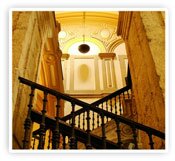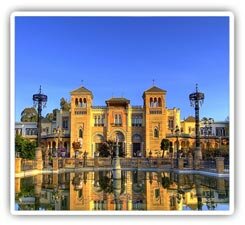
Learn Spanish in Sevilla
Sevilla is probably the classic heart of Spain where you can find every typical Spanish tradition: sun, tapas, flamenco, colourful religious processions, bull-fighting, the siesta, late nights and amazing architecture to name but a few.
On the other hand, Sevilla is not standing still and is a wonderful place for nightlife, art, shopping and restaurants.
You'll find that it is almost impossible not to have a good time in this beautiful city. As the capital of Andalucia, you're never far away either from discovering the beauty and charm of southern Spain.
Wide selection of Spanish courses
The following Spanish courses are taught in Sevilla:
- Intensive Course - 20 classes per week
- Intensive Course 20+5 - 20 classes per week + 5 culture classes
- Super-Intensive Course 30 - Intensive 20+5 + 5 conversation classes
- Inmersión - Intensive course + 5 or 10 private classes per week
- Español Expres - 20 or 30 private classes per week
- Individual classes
- Spanish + Flamenco - Intensive course + 5 Flamenco classes
New Intensive and Super-intensive courses start every Monday and you can study spanish for as long as you want between 1 week and a full academic year (great idea for a gap year or sabbatical). We distinguish 6 different Spanish levels so there is always a group that is right for you.
» Learn more about our Spanish courses
Sevilla, historic capital of Andalusia
 The more you learn about Spain, the more you will realise that Spain’s regional diversity is immense in terms of culture, history and customs. The roots of Seville go back to before the Romans (who called the city Hispalis) and legend has it that the city was founded by the Greek hero Hercules.
The more you learn about Spain, the more you will realise that Spain’s regional diversity is immense in terms of culture, history and customs. The roots of Seville go back to before the Romans (who called the city Hispalis) and legend has it that the city was founded by the Greek hero Hercules.
The region of Andalusia came to prominence when the Moors landed in Southern Spain in the beginning of the 8th century and made this part for many years the heart of Arab culture. Cordoba, Granada and above all Sevilla became important cities where art and science thrived and Arab rulers built impressive monuments.
When the Moors were driven off the Iberian peninsula in 1492 by Christian forces, Seville continued to thrive as the seafaring port of Spain, trading the newly found riches in the Americas until the river Guadalquivir that connects Seville to the Atlantic Ocean started to silt up.
At the crossroads of East and West
Seville offers a rare melting pot of customs and styles that seem to blend together without any effort. The strong Gypsy presence in Andalusia gave it the Flamenco dance and guitar without which Spain would not be the same.
The Moors left behind monumental architecture and the use of bright colours and motifs that still dominate the region. The Catholic Church brought the world famous festivals of “Semana Santa” and re-invigorated Seville with spiritualism that you do not find easily in other places.
As an example, the Cathedral of Seville is partly the remodelled mosque that once stood there and Seville’s most famous landmark, “la Giralda”, is in fact the minaret of the ancient mosque.
» Read more about our Spanish language school in Sevilla
Barcelona
- Occidental Barcelona 1929
- Occidental Diagonal 414
- Ilunion Bel-Art
- Hotel Peninsular Barcelona
- Ohla Eixample Barcelona
- Alimara Hotel Barcelona
- Hotel Via Augusta






